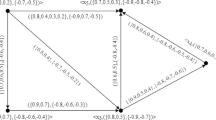Abstract
In the 1970s Codd introduced the relational algebra, with operators selection, projection, union, difference and product, and showed that it is equivalent to first-order logic. In this paper, we show that if we replace in Codd’s relational algebra the product operator by the “semijoin” operator, then the resulting “semijoin algebra” is equivalent to the guarded fragment of first-order logic. We also define a fixed point extension of the semijoin algebra that corresponds to μGF.
Similar content being viewed by others
References
Abiteboul, S., Hull, R., and Vianu, V., 1995, Foundations of Databases, Addison-Wesley.
Andréka, H., Hodkinson, I., and Németi, I., 1999, “Finite algebras of relations are representable on finite sets,” Journal of Symbolic Logic 64(1), 243–267.
Andréka, H., Németi, I., and van Benthem, J., 1998, “Modal languages and bounded fragments of predicate logic,” Journal of Philosophical Logic 27(3), 217–274.
Beeri, C., Fagin, R., Maier, D., and Yannakakis, M., 1983, “On the desirability of acyclic database schemes,” Journal of the ACM 30(3), 479–513.
Codd, E., 1970, “A relational model of data for large shared data banks,” Communications of the ACM 13(6), 377–387.
Codd, E., 1972, “Relational completeness of data base sublanguages,” in Rustin, R. (ed.), Data Base Systems, pages 65–98. Prentice-Hall.
Ebbinghaus, H.-D. and Flum, J., 1999, Finite Model Theory, Springer.
Flum, J., Frick, M., and Grohe, M., 2002, “Query evaluation via tree-decompositions,” Journal of the ACM 49(6), 716–752.
Garcia-Molina, H., Ullman, J., and Widom, J., 2000, Database Systems: The Complete Book, Prentice Hall.
Gottlob, G., Grädel, E., and Veith, H., 2002, “Datalog LITE: A deductive query language with linear time model checking,” ACM Transactions on Computational Logic 3(1), 42–79.
Grädel, E., 1999a, “Decision procedures for guarded logics,” in Proceedings of the 16th International Conference on Automated Deduction, vol. 1632. Springer-Verlag.
Grädel, E., 1999b, “On the restraining power of guards,” Journal of Symbolic Logic 64(4), 1719–1742.
Grädel, E., 2002, “Guarded fixed point logics and the monadic theory of countable trees,” Theoretical Computer Science 288(1), 129–152.
Grädel, E., Hirsch, C., and Otto, M., 2002, “Back and forth between guarded and modal logics,” ACM Transactions on Computational Logic 3(3), 418–463.
Grädel, E. and Walukiewicz, I., 1999, “Guarded fixed point logic,” in Proceedings of the 14th IEEE Symposium on Logic in Computer Science LICS ‘99, pages 45–54.
Halmos, P., 1962, Algebraic Logic, American Mathematical Society.
Halpern, J., 1995, “The effect of bounding the number of primitive propositions and the depth of nesting on the complexity of modal logic,” Artificial Intelligence 75(2), 361–372.
Hoogland, E. and Marx, M., 2002, “Interpolation and definability in guarded fragments,” Studia Logica 70(3), 373–409, April.
Leinders, D., Tyszkiewicz, J., and Van den Bussche, J., 2004, “On the expressive power of semijoin queries,” Information Processing Letters 91(2), 93–98.
Marx, M., 2001, “Tolerance logic,” Journal of Logic, Language and Information 10(3), 353–374.
Marx, M. and Venema, Y., 2004, “Local variations on a loose theme: Modal logic and decidability,” in Grädel, E., Kolaitis, P., Libkin, L., Marx, M., Spencer, J., Vardi, M., Venema, Y., and Weinstein, S., (eds.), Finite Model Theory and its Applications, Springer-Verlag.
Németi, I., 1995, “A fine-structure analysis of first-order logic,” in Marx, M., Pólos, L., and Masuch, M., (ed.), Arrow Logic and Multimodal Logics, Studies in Logic, Language and Information, pages 221–247. CSLI Publications, Stanford.
van Benthem, J., 1997, “Dynamic bits and pieces,” Technical Report LP-1997-01, ILLC.
Yannakakis, M., 1981, “Algorithms for acyclic database schemes,” in Proceedings of the 7th International Conference on Very Large Data Bases, pp. 82–94. IEEE Computer Society.
Author information
Authors and Affiliations
Corresponding author
Additional information
This author has been partially supported by the European Community Research Training Network “Games and Automata for Synthesis and Validation” (GAMES), contract HPRN-CT-2002-00283.
Rights and permissions
About this article
Cite this article
Leinders, D., Marx, M., Tyszkiewicz, J. et al. The Semijoin Algebra and the Guarded Fragment. J Logic Lang Inf 14, 331–343 (2005). https://doi.org/10.1007/s10849-005-5789-8
Issue Date:
DOI: https://doi.org/10.1007/s10849-005-5789-8



